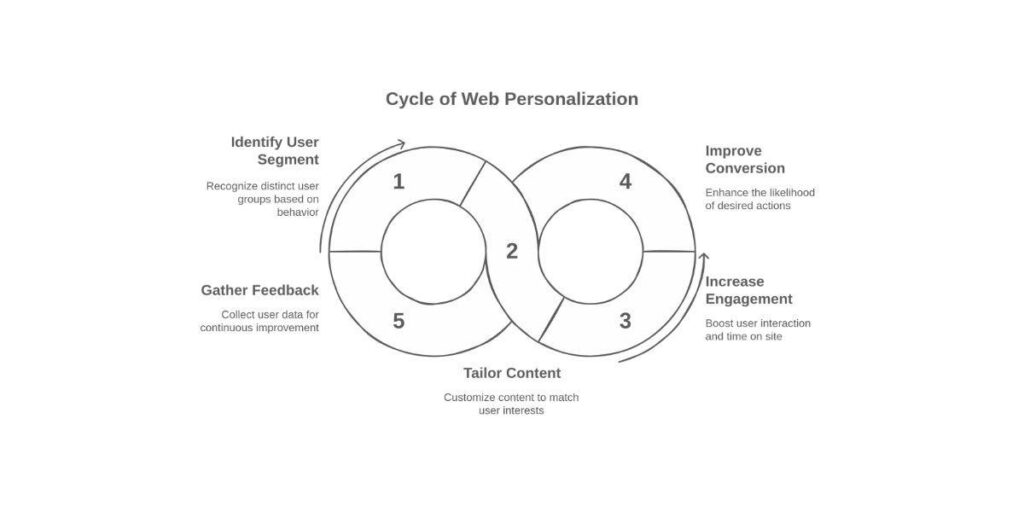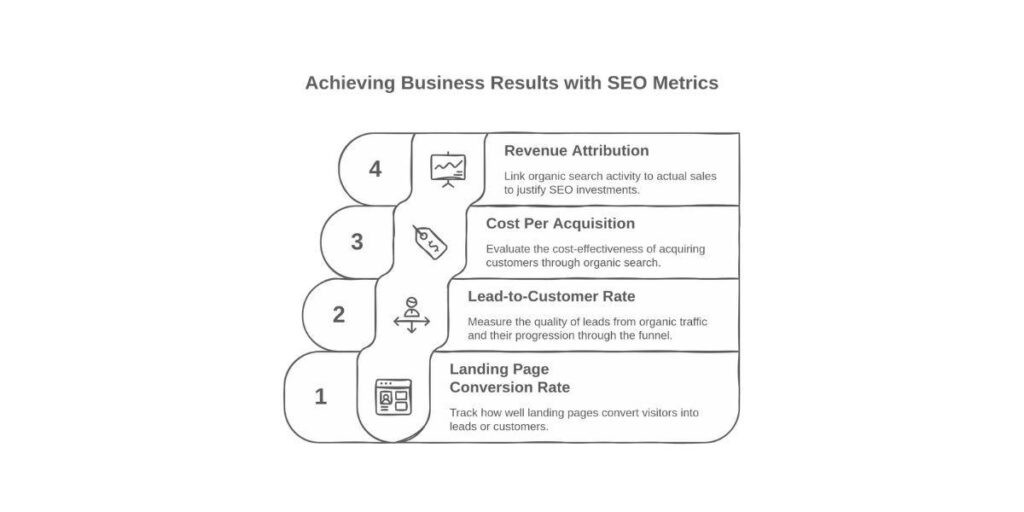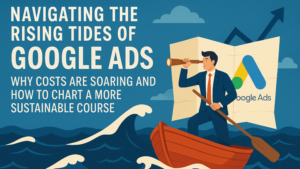Ever looked at website analytics and thought, “There’s a lot of traffic here,” only to wonder why the leads or sales aren’t coming in? Visitors arrive through search, spend time on your site, but then leave without taking any action. Something feels off.
SEO is often considered the key to growth. Rank higher, get more clicks and the rest will follow. But what happens once someone lands on the site is just as important. A strong SEO strategy doesn’t stop at visibility. It shapes the entire journey.
Yet many strategies ignore that. Instead of taking the visitor to a choice, they halt at the search result. That’s a missed opportunity. Only 39.6 percent of businesses have a documented conversion strategy, meaning most aren’t thinking beyond the click.
And while SEO is still a priority, with 57 percent of B2B marketers citing it as their most effective digital channel, its true value depends on what visitors do once they arrive. Without a plan to drive them forward, traffic alone won’t deliver growth.
The gap is evident in how budgets are spent. For every $92 invested in attracting visitors, only one dollar is invested in converting them. This imbalance signals a necessary shift in the strategy.
This blog explores exactly that. How to shift from traffic-first thinking to a conversion-focused SEO strategy, how search engines are rewarding better user experiences and how tools such as personalization can transform passive visits into meaningful outcomes.
Why SEO Should Focus On Conversions, Not Just Traffic
Now that we’re moving beyond traffic alone and looking at what visitors actually do on a site, the next question naturally follows. What makes an SEO strategy truly geared towards conversions?

It starts with intention. Traditional SEO often aims for high visibility by targeting general keywords. But this approach can be ineffective if the people arriving aren’t ready to engage. A conversion-first approach is focused on more targeted, decision-based searches, such as the best software for small business accounting. With these kinds of queries, you know that the visitor is actively considering options.
This shift towards intent also brings user experience into focus. Search engines have become smarter. They now focus on how users interact with a page. If the site loads slowly and/or feels clunky, visitors leave. A seamless and trustworthy experience not only helps the users. It boosts visibility, too. In fact, optimizing website experience can increase conversion rates by as much as 400%.
Then there’s content. Not just pages that rank, but ones that persuade. When content can answer real questions, compare the options, and address the doubts, it can help take someone a step closer to a decision. Every product page, case study, or CTA should not only inform. It should guide.
But even the greatest of content needs a strong foundation. A site that’s mobile-friendly, secure, and easy to navigate provides both users and search engines with what they need. It eliminates friction, allowing the rest of the strategy to work as intended.
Together, these pieces are the backbone of a conversion-focused SEO strategy. Align with intent. Prioritize experience. Write to persuade. Build on good technical foundations. This is how SEO becomes more than just a visibility tool. It becomes a real engine of growth.
And the results prove it. Commercial intent keywords frequently convert at more than 10%. That’s the difference between traffic that just visits and traffic that does something.
How Search Engines Have Changed
After understanding what makes an SEO strategy effective for conversions, the next step is to recognize why this is more important than ever. Search engines have changed the rules. And these changes have made the old ways of doing SEO less effective.
For years, SEO was all about keywords. Placing the right phrases at the right places could help improve a page’s ranking. But now that’s not enough. Google’s more recent updates, such as the Helpful Content System, center around whether or not a page is actually providing value. Content is ranked based on how helpful and satisfying it is for the person reading it. Pages that simply repeat keywords without adding substance are being left behind.

This shift rewards the same principles discussed above. Aligning with the user intent, creating meaningful content, and enhancing the user experience are now essential. Search engines are seeking out pages that do more than just exist. They want pages that solve problems.
That’s also why some older SEO tactics no longer work. Keyword stuffing and superficial link building can no longer result in good engagement and even lower rankings. The focus has been shifted from tactics to outcomes. A page must be of real value to the person who comes across it.
And that leads to the next step in the evolution of SEO. If the goal is to provide a better experience, then it makes sense to personalize that experience for each visitor. This is where personalization comes into play. When a site can change based on the behavior, location, or preferences of an individual, the content becomes more relevant. And relevance is what both users and search engines care about.
76% of customers are frustrated when content is not relevant to their interests or past behavior. That frustration can translate into lost conversions. A more personalized experience keeps people engaged, and engaged visitors are more likely to take action.
Personalization And Its Impact On SEO
As search engines continue to reward relevant and helpful experiences, the next step is obvious. If SEO is now about fulfilling intent and driving action, then personalization is what makes that journey truly effective.

Rather than presenting the same content to everyone, a website can adapt dynamically through personalization. Visitors view what resonates with their needs and interests, resulting in longer visit times and increased opportunities for conversion. Research shows that Personalized CTA alone have performed more than twice as well as generic ones.
And small changes like these can make a big difference. A visitor looking for CRM software for startups, for example, might see a page geared toward that particular use case. Another visitor may see something else entirely. This immediately increases relevance and keeps people engaged, which search engines recognize as a quality signal.
This is where a web personalization platform is essential in achieving these dynamic experiences at scale by recognizing different user segments and automatically displaying the most relevant content. Whether it is updating a headline or adjusting calls to action, these platforms make it easier to deliver the right message at the right time.
Personalization also helps visitors move through the site more naturally. A new visitor may be shown a product demo. A returning one might find a case study that fits their industry. These experiences lower friction and increase the likelihood of action.
It also works silently in the background. If someone has downloaded a guide or placed a product in their cart, the site can react with more relevant options. These little adjustments help users feel like they’re making a difference and keep them engaged. Companies utilizing advanced personalization are already seeing strong returns, in some cases resulting in a $20 return for every dollar spent.
Imagine a visitor is looking for winter running jackets for women. The page they land on displays products in their size and style. As they explore, recommendations change based on their clicks. The experience is smooth and personal. Each interaction communicates to search engines that the page is relevant and worth ranking.
By structuring content around intent and using a web personalization platform to deliver it in real time, SEO becomes more than a discovery tool. It becomes a straight pathway to conversions.
SEO Metrics That Actually Drive Business Results
After building a strategy around intent and leveraging tools such as a web personalization platform to influence the journey, the final step is measuring what’s really driving results. Because without precise measurement, it’s hard to know what is working.
Traditional SEO was focused on surface-level metrics such as keyword rankings or traffic volume. While these still provide context, they don’t offer actual business impact. A page can attract visitors, but fall short if those visitors don’t convert.

- Conversion Rate by Landing Page:
To track meaningful progress, one of the more important metrics is conversion rate by landing page. This reveals which pages are successfully converting visitors into leads or customers. It helps teams focus their efforts on what’s working and where there’s room for improvement.
- Lead-to-Customer Rate:
Another important metric is the lead-to-customer rate. The rate indicates the quality of leads that are coming from organic traffic and how well they are moving through the funnel. This makes it easier to compare SEO with other acquisition channels.
- Cost Per Acquisition (CPA) from Organic Search:
Cost per acquisition from organic search is also worth keeping track of. While paid ads provide faster results, organic traffic often leads to more sustainable growth at a lower cost. Measuring this helps teams see the long-term value of SEO efforts.
- Revenue Attribution:
Revenue attribution takes it all together. By linking organic search activity to real sales, it’s easier to justify investments in SEO and make decisions that are driven by performance and not assumptions.
Several tools are available to capture this data. Google Analytics 4 measures user behavior and conversions. Google Search Console displays how pages are doing in search. Combined with CRM insights, these tools provide a complete picture of what is driving growth.
Companies that use data to inform their marketing strategies are more likely to be profitable. Yet many still overlook important tracking methods. Fewer than 30% of small businesses are actively using tools to measure performance, leaving valuable opportunities to optimize.

FAQ: Turning Website Visitors Into Customers Using SEO
1. What does it mean to convert visitors using SEO?
It means using SEO to attract the right audience and guide them to take action — like making a purchase or filling a form.
2. Why is SEO important for conversions?
SEO brings qualified traffic and builds trust. When optimized for user intent, it increases both visibility and sales.
3. How can I make my website convert better?
Focus on fast loading, mobile-friendly design, clear CTAs, and persuasive content that matches user intent.
4. What type of keywords help in conversion?
Target commercial and transactional keywords such as “hire SEO expert” or “best digital agency,” not just informational ones.
5. Does user experience affect conversions?
Yes. A smooth, intuitive website with trust signals (reviews, testimonials) keeps visitors engaged and ready to act.
6. How long does it take to see results?
SEO and conversion improvements usually show noticeable results within 3–6 months.
7. Can this work for all business types?
Yes — whether B2B, B2C, or e-commerce, aligning SEO with customer intent boosts conversions across industries.
8. Should I hire an agency or do it myself?
You can start yourself, but an experienced agency like Digitalz Pro Media can accelerate results and handle technical SEO efficiently.
Conclusion:
SEO today is no longer solely about driving traffic. It is about putting the right visitor on the right track to the right action. As algorithms reward relevance and intent, the way forward is clear. High-performing companies use a robust SEO foundation, coupled with clever personalization and targeted measurement, to make their website a reliable growth engine.
The advice is simple. Stop measuring visits in isolation. Start tracking the impact of those visits. Pick one key page, personalize the experience, and watch the difference. SEO and personalization are not distinct strategies. Together, they build the quickest path from search to sale.
Author Bio: Vidhatanand is the Founder and CEO of Fragmatic, a web personalization platform for B2B businesses. He specializes in advancing AI-driven personalization and is passionate about creating technologies that help businesses deliver meaningful digital experiences.
Disclaimer: Disclaimer: The views and opinions expressed in this article are those of the author and do not necessarily reflect the official policy or position of Digitalz Pro Media & Technologies.





